According to the July LANDTHINK Pulse results, 39.5% of respondents would be inspired to purchase a hunting property with a year-round water feature in the form of a pond, stream, lake or river. Land is one thing all hunters have in common, yet securing a quality piece of land can be the most challenging part of hunting. The majority of hunting in the U.S. is done on public land, and while hunting public land can be quite good in some parts of the country, it often brings a lot of frustration. Every year, more and more disenchanted hunters are seeking out hunting land to buy. Owning your own hunting land gives you the freedom to manage the wildlife on the property as you see fit, and your family and friends can enjoy the recreational opportunities the property affords during the off season like camping, hiking, fishing, riding ATV’s, or horseback riding. If you find the right piece of property, land is an excellent investment for the long term and can present annual income opportunities.
July Pulse Sponsored by
Last month, the July Pulse asked: What one feature about a hunting property would make you more likely to buy?
When it comes to real estate, we all know that nothing beats location, but according to last month’s Pulse result’s, the existence of a prominent water feature is a principal motivating factor for those looking to buy hunting land. The results were not surprising. Back in 2012, The LANDTHINK Pulse asked our audience: What improvement or feature do you think land buyers consider most desirable when purchasing land? That month’s survey question revealed that Water Feature Thought to be the Most Desirable Property Characteristic when purchasing land. A water feature is a physical characteristic of property that adds both value and enjoyment. Water is a haven for all types of wildlife, and it can be used for irrigation or watering livestock, and offers benefits you can’t value monetarily, such as fishing, boating or swimming.
Generally, any water feature adds to the value of land and these properties often come at a premium to the asking price. A water source is a crucial habitat feature when buying land for the purpose of hunting. Opinions vary, but it’s believed that a deer needs approximately 2 to 3 quarts of water per day per 100 pounds of body weight. Given that, the land you ultimately purchase should provide a steady source of year-round water to maximize hunting success.
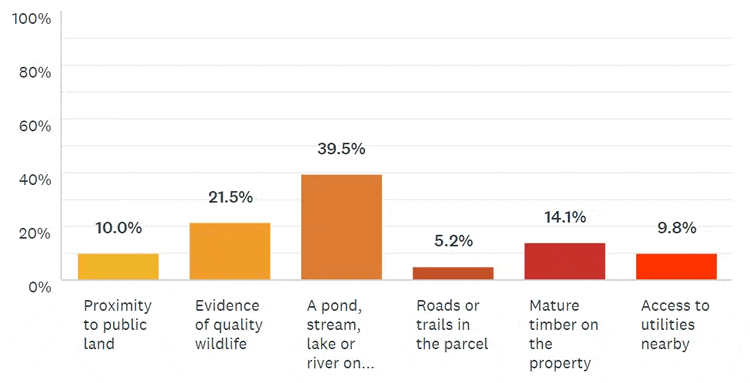
Coming in a close second, 21.5% of our LANDTHINK audience said that evidence of quality wildlife on hunting land they were considering would make them more likely to purchase the property. Signs of wildlife is one of the most important things buyers should take into consideration before signing on the dotted line to make the land their own. Scouting the land yourself (with the current landowner’s permission) and looking for tracks, sheds, rubs and scrapes, can provide confirmation that the land will be conducive for hunting success. A land agent that is experienced in recreational land for sale can help you assess the habitat diversity of a piece of land.
In his LANDTHINK article, Rod Osterloh, a member of the PotlatchDeltic Preferred Broker Network, offers tips for assessing the wildlife on a property you are considering. “Visit each property you’re considering with someone who knows how to look for the telltale signs that deer, turkey and other types of wildlife leave behind,” Osterloh suggests.
When searching land for sale websites like LANDFLIP, you will see that many land agents include trail camera images with property photos, to provide buyers with a unique insight into the wildlife that inhabits a property, the patterns of deer on a property, and to help reveal the odds of harvesting a future trophy whitetail. While trail cameras can provide potential buyers with solid evidence on either the presence or absence of a wildlife species, the information they provide isn’t always a 100% accurate picture. If the camera is going to provide the most reliable information, there’s a long checklist that should be followed to insure proper placement on the property in order to achieve the most accurate wildlife assessment.
Rusty Hamrick, broker with NAI Earle Furman, talks about how more recreational land buyers are emerging, and seeking out properties with habitat diversity, in his LANDTHINK article Habitat Diversity and Quality Hunting Properties: Valuable Assets in the Current Land Market. “Rural properties that offer a variety of wildlife habitat tend to stand out thanks to excellent resident wildlife populations. This argument is important to sellers due to the historical trend that buyers in the market for quality hunting tracts are often more inclined to negotiate on price when they recognize that a property has good habitat diversity in place and therefore offers immediate high-quality hunting opportunities.”
Mature timber on the property came in third, with 14.1% of respondents saying that is the factor that would influence their decision on whether or not to purchase a hunting property. If existence of mature timber is of utmost importance, first and foremost you should ensure that the timber rights will be sold along with the hunting land. A land agent can you get the answers to other important questions regarding the timber stand such as: Has the timber been harvested before? Can it be cut again? The long-term effect of harvested timber stands can be very good for the habitat and deer. Fresh growth promotes plenty of food for whitetails and creates ideal habitat for bedding areas.
Recreational land buyers might want to generate cash to help with the carrying costs associated with owning land and turn their dream hunting property into an income generator. Sustainably managed timberland can provide income from a hunting property as well as excellent wildlife habitat for hunting and recreational opportunities. However, preparing for a timber harvest is complicated. Most land agents will advise their buyer clients to have an experienced forester to walk them through the process. Just because you see a lot of standing trees when walking the property, doesn’t mean there’s a profit there. Many factors impact the value of a timber stand such as the size of trees, species, accessibility, and current market conditions.
Making the decision to buy your own hunting land can be very rewarding and a wise investment for you and your family. With a little research and planning, you can rest assured you are getting the property you want and a beautiful recreational family retreat for generations to come. Owning your own hunting land also provides lucrative possibilities- the more improvements you make to the land, the more income potential you will have. When contemplating the purchase of hunting land for sale, ask yourself how much value you place on having a good place of your own to hunt and how much enjoyment you will experience from owning it. Don’t worry about the conditions of the market in a future you cannot control.
The LANDTHINK Pulse revealed a miscellany of influencing factors that motivate buyers of hunting property. The results were all over the board, but the largest percentage (39.5%) indicated that live water (pond, stream, lake or river) would nudge their decision making process, followed closely by 21.5% of our audience, who indicated that they would be persuaded to purchase by evidence of quality wildlife. A large percentage (14.1%) said that mature timber on the property would make them more likely to buy it. Proximity to public land (10.0%), access to utilities nearby (9.8%), and roads or trails in the parcel (5.2%) were of least appeal to respondents when evaluating a hunting property.
LANDTHINK would like to thank PotlatchDeltic for sponsoring the July Pulse and for coming up with a very interesting question to pose to our audience. PotlatchDeltic is a leading Real Estate Investment Trust (REIT) that owns nearly 1.9 million acres of timberland in Alabama, Arkansas, Idaho, Minnesota, Louisiana and Mississippi. PotlatchDeltic, a leader in sustainable forest practices, is committed to providing superior returns to stockholders through long-term stewardship of its forest resources. The company also conducts a land sales and development business and operates wood products manufacturing facilities through its taxable REIT subsidiary.
Become a Pulse sponsor! It’s a great way to ensure your brokerage is the first one buyers and sellers call when they have a need to buy or sell property. You’ll get insane exposure on Social + Email + Web. That’s 500,000+ monthly eyes on you! Once you have it, you won’t want to give it up! Pulse sponsorships are offered on a first come first served basis and are subject to certain limitations. If your business would be interested in sponsoring a Pulse question, please contact us soon.
Do you have a Pulse question you’d like to suggest? Submit your question and we might choose yours!
We want to know what you think about our August Pulse question, chosen and sponsored by Tutt Land Company: In your opinion, what impact does a long term lease (farm, timber, etc) have on land value? Answer now.
This content may not be used or reproduced in any manner whatsoever, in part or in whole, without written permission of LANDTHINK. Use of this content without permission is a violation of federal copyright law. The articles, posts, comments, opinions and information provided by LANDTHINK are for informational and research purposes only and DOES NOT substitute or coincide with the advice of an attorney, accountant, real estate broker or any other licensed real estate professional. LANDTHINK strongly advises visitors and readers to seek their own professional guidance and advice related to buying, investing in or selling real estate.






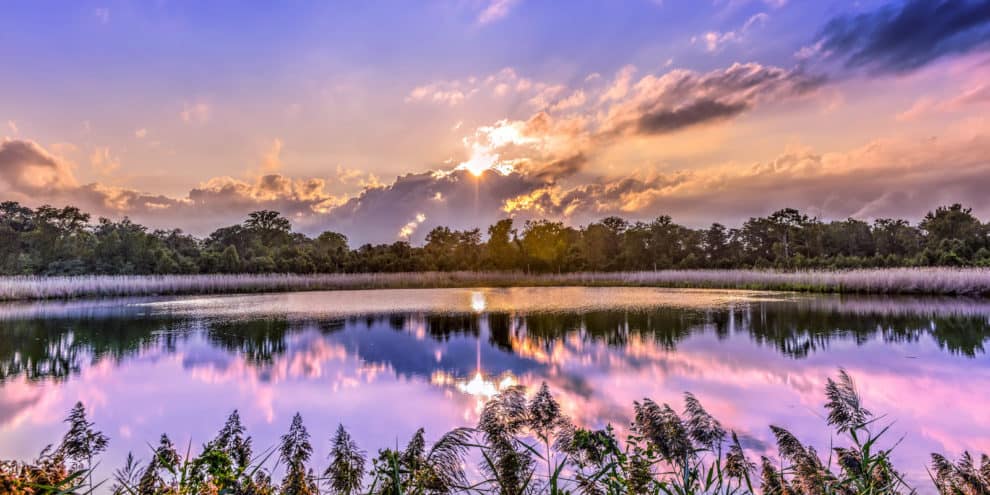

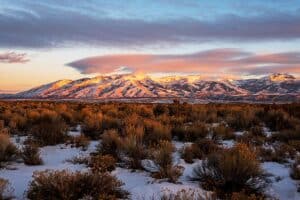
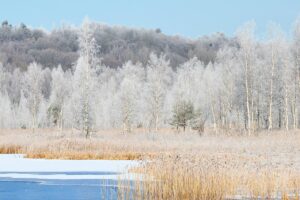
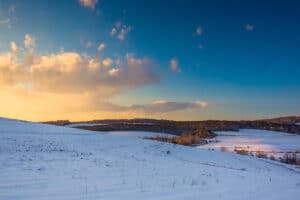
These water features are what make this land stand out, and be unique to other similar properties. The features here are fantastic, and I am glad someone is finally talking about them. I am happy that you posted this here.
If there is anyone who is looking for land then I would suggest them to buy one that is near a water source. This would definitely affect the value of the land when you sell it.